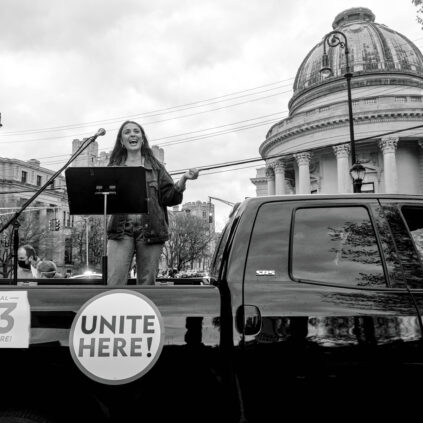
When two groups of Yale Law students arrived in Dilley and Karnes, Texas, in the spring of 2015, the detention centers they saw housed over two thousand asylum seekers. The people inside were overwhelmingly women and children fleeing rising violence in Central America’s Northern Triangle, and the volunteers intended to help them stay in the United States. They were there to conduct interviews, to ask the families what they had experienced that would help them win their cases in front of a government judge.
Swapna Reddy LAW ’16 described the first center she visited as a “jail made out of trailers.” The Yale Law students saw asylum seekers locked twelve to a room in crowded cells. They talked to mothers whose children had vomited for several days straight; when they asked for assistance, the center’s medical staff prescribed more water. Many of the pro-bono lawyers working at Dilley, Reddy told me, called it “baby jail.” They set up makeshift offices to record women’s informal testimonies about their persecution while their children watched cartoons or made up games about court proceedings, miming the lawyers.
Guatemala fled gang violence to cross the Rio Grande and make it into the U.S. The Karnes center had been open since 2010, and it could hold five hundred people. The
The detention centers at Karnes and Dilley have been criticized for their bleak conditions. The government’s response is that it had to deal quickly with the unanticipated migrant surges. Most of the migrants from El Salvador, Honduras, and one in Dilley opened in December 2014, after a historic spike in the number of asylum seekers. It is the biggest in the country, with a maximum capacity of 2,400. Both centers are operated by private prison corporations.
Reddy and the four others on the trip assisted one asylum seeker through a successful hearing and many others with their preliminary interviews. When they returned to New Haven, Reddy and Conchita Cruz LAW ’16 formed the Yale Asylum Seekers Advocacy Project (ASAP) to continue their work from afar—poring over intake files, reading transcripts of interviews with officials, and conducting phone interviews to prepare the information the lawyers on the ground would need.
There was a fatal flaw in the government’s plan: hundreds of families did not get the letters, and many who did get the letters did not understand that they could be deported if they did not attend their hearings.
The initial asylum process has three stages: a preliminary interview to establish “credible fear” (a legal term indicating the asylum seeker has reason to fear for her life should she return to her home country), a “merits” hearing (where the immigration judge makes a first decision about the credibility of the asylum case), and a final hearing. Around August 2015, the government began releasing asylum seekers on bond after the initial interview, with only a letter following them to notify them of the hearings that would occur many months later. Previously, it had held them at the centers for longer periods before releasing them. There was a fatal flaw in the government’s plan: hundreds of families did not get the letters, and many who did get the letters did not understand that they could be deported if they did not attend their hearings.
By October, legal assistants began to understand the scope of the problem. One of the main organizations working at the detention centers, CARA, a coalition of immigrant advocacy groups, maintains a database of information about asylum seekers. This database covers only the asylum seekers who have interacted with CARA (as of publication, approximately six thousand), just a fraction of the total flow, Reddy says.
With the information from CARA, ASAP can call into a government hotline, obtain information about upcoming hearings, and notify women about their court dates. The voice on the other end of the line has the flatness of an official recording: “Welcome to the automated case information hotline,” a woman’s voice says with little inflection. The recording is a little too loud, and a little too repetitive: “The alien registration number, also known as the A-number, begins with the letter A and is followed by an eight- or nine-digit number.” It is neither hostile nor friendly, but the flatness is unsettling. “Please enter those numbers now.” The Yale volunteers have heard these recordings dozens of times—the same message appears every time they call.
About two hundred Yale Law students and undergraduates filed into room 127 in the Sterling Law Building in late October. Armed with laptops and phones, they turned the lecture hall into a call center. They dialed for hours. The room was mostly quiet as they typed numbers identifying asylum seekers into their phones; occasionally, someone would get information about an upcoming hearing and yell. (Alina Aksiyote, a volunteer, told me that the number entered often has no record to match, either because the asylum seeker has been deported or a hearing has not yet been scheduled.) Pizza appeared, and the volunteers ate. Then they kept dialing. This went on from six to nine at night and happened again the next day, and the day after.
Armed with laptops and phones, they turned the lecture hall into a call center. They dialed for hours.
ASAP got through the backlog of approximately four thousand released asylum seekers during the initial flurry in October. Twenty or so volunteers drawn from the seven other schools affiliated with ASAP, including the law schools at Columbia, Georgetown, and DePaul, now aim to assist a few hundred people per week. They work from a spreadsheet, filling logistical details into a script they send out through texts. “Hello,” it begins, in Spanish. “I am a volunteer with the group that helped (name) when she was detained. This is a reminder that (name) has an immigration court hearing on (date) at (time) in (city, state).” The asylum seekers often do not have cell phones; these messages go to their family, friends, or hosts, who are listed in the database. It continues: “It is very important that she attend this hearing, as not attending might result in her deportation.”
One of the volunteers, Charlotte Finegold ’17, described it as sending texts “out into the ether.” Sometimes, those who text back ask if ASAP can help friends with legal problems. Many reply with something far briefer: “Muchas gracias.”
ASAP seeks to guide asylum seekers around the flaws of a system which the government could fix but hasn’t. This lack of official aid, for Reddy, is the most emotionally exhausting part of the work. The detention centers, the broken notification system for hearings, the hair-trigger threshold for deportation—ultimately, the government is treating these people not as asylum seekers, but as criminals, according to Reddy. Her consolation is the attorneys at the detention centers; the volunteers updating the database in New Haven; the churches in Texas where asylum seekers and their children receive backpacks full of clothes and food.
What else is there to do when you’re wrestling with World War II-era refugee conventions, state-subsuming criminal gangs a continent away, and an impersonal federal bureaucracy? Prepare twenty-five document collections a week. Send two hundred texts. Scale up, expand. Expect that the system can change, and try to temporarily cover its cracks.


